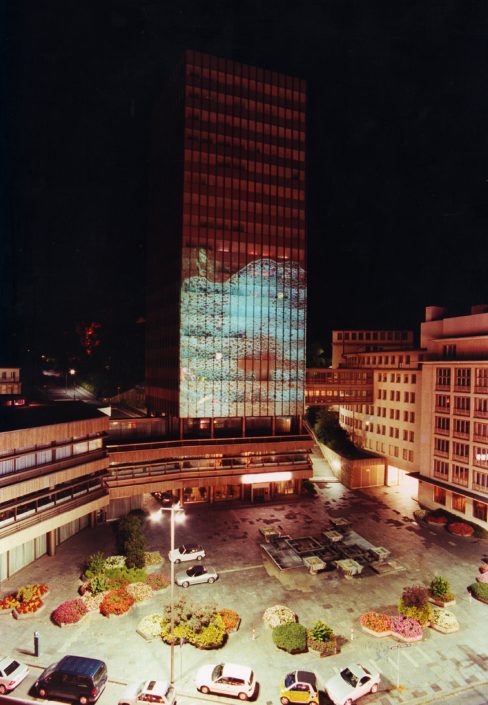Schaumschläger [foam beater], 2002
Video installation, Wiesbaden
In the work “Schaumschläger” for the city of Wiesbaden, the high-rise office building of the R+V insurance at the upper end of Wilhelmstrasse – which is not illuminated at night, neither inside nor outside – attracts more and more attention due to a video projection. Foaming water rises slowly up half the front of the building all evening between nine pm and midnight. Occasionally, a yellow toy diver swims across the picture; ending up on dry land, a green lawn that is, in between. The image projected sets the strictly geometrical facade of the building in motion, the solid square grid is confronted with the intangible, ephemeral materiality of foam. In turn, the image becomes squared by the right angled structure of the face of the building, the horizontal bands of windows and metal panels leading it in waves up the front. –
The individually varying film sequences last between three and eight minutes; they repeat after half an hour. This striking, but not in the least gaudy, in parts even child-like mise-en-scene allows the building to evoke completely different associations from those inspired during the day or at night with the lights off. The architectural box – prototype of modern town architecture – gets handed a nightgown. Whether this works for the building or against it, cannot be decided, the question itself is indeed quite meaningless. But who knows? Perhaps the building will appear once again in a different light, once artistic bathing has left Wiesbaden?
The idea arose while thinking about the town‘s medieval name – Wisibada –, which sounds rather funny in today’s German usage (Like the medieval one, the modern name translates literally into „Wies’“ and „baden“ – „meadow“ and „bath/spa“), and it gained momentum by contemplating the local champagne cellars and the annual wine festival, the hot springs and the town as a short term centre of the Fluxus art movement.
Schaumschläger, 2002
Videoinstallation, Wiesbaden
In der Arbeit “Schaumschläger” für Wiesbaden gerät das Bürohochhaus der R+V-Versicherung am oberen Ende der Wilhelmstrasse – das nachts weder von innen noch von außen beleuchtet ist – durch eine Videoprojektion in den Blick. Abends zwischen neun Uhr und Mitternacht fließt langsam schäumendes Wasser über die halbe Gebäudefront nach oben. Zuweilen schwimmt ein gelber Spielzeugtaucher durchs Bild;
zwischendurch landet er auf dem Trockenen, einem grünen Rasen. Das projizierte Bild setzt die streng geometrisch gegliederte Fassade des Gebäudekomplexes in Bewegung, das quadratische Raster wird konfrontiert mit der nicht greifbaren, vergänglichen Materialität des Schaums. Umgekehrt wird das Bild durch die rechtwinklig strukturierte Fassade der Architektur kubisch gerastert und durch die sich waagerecht abwechselnden Fenster und Metallflächen in Wellen über die Gebäudefront geführt. –
Die einzelnen variierenden Filmsequenzen dauern zwischen drei und acht Minuten; sie wiederholen sich nach einer halben Stunde. Mit dieser auffälligen, aber keinesfalls grellen, zum Teil kindlich anmutenden Inszenierung weckt der Bau ganz andere Assoziationen als bei Licht am Tag oder dunkel in der Nacht. Die architektonische Schachtel – der Prototyp moderner städtischer Architektur – bekommt ein Nachtkleid zugeworfen. Ob es dem Gebäude gut tut oder nicht, ist unentscheidbar und sogar eine sinnlose Frage. Aber vielleicht wird es demnächst einmal in einem anderen Licht erscheinen, wenn Kunstbaden wieder abgetaucht ist in Wiesbaden.
Der Idee liegen Gedanken an den mittelalterlichen Namen der Stadt – Wisibada –, der uns im heutigen Sprachgebrauch recht lustig klingt, an die Sektkellereien und das alljährliche Weinfest, an die heißen Quellen und die Stadt als kurzzeitige Wirkungsstätte der Fluxus-Kunstbewegung zugrunde.





